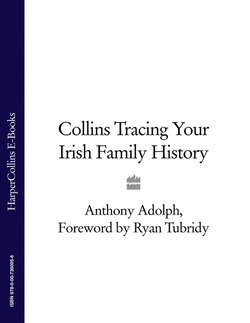Читать книгу Collins Tracing Your Irish Family History - Ryan Tubridy, Anthony Adolph - Страница 11
The consequences of famine
ОглавлениеWhether potatoes reached Ireland with Sir Walter Raleigh, or from Spain (as their early Irish name, an spáinneach, suggests) is open to question. They first appear in a lease in Co. Down of 1606. They were grown initially to break up soil in fields used for cereals. By the late 18th century, most grain was grown for landlords to export, and the potato had become the peasants’ staple crop. Potatoes were boiled and eaten, and mixed where possible with milk or fish.
Peasants tied to the land tended to marry young, thus producing large families. Nourished by potatoes, the population grew from 2 million in 1700 to 2.3 million in 1754, 5 million in 1800 and 8 million in 1841. There were scarcely any industrial towns to soak up this excess population, so peasant landholdings had to be subdivided, making families dependent on increasingly tiny plots.
The potato harvest had failed occasionally, but from 1821, when the crop failed in Munster and many people in Cork and Clare starved, a series of calamities took place. In Irish folklore, the famine-bringing fairy was the Fear-Gorta, the ‘man of hunger’, who stalked the land as an emaciated beggar. He reappeared again with fresh crop failures in 1825–30, followed by ‘stark famine’ in Munster and south Leinster in 1832. Thenceforth, the crop failed periodically.
Despite their terrible living conditions, relatively few Catholics had left Ireland. Besides legal restrictions on their movement, not lifted until 1827, both poverty and an emotional tie to their ancestral land kept most in Ireland. Between 1827 and 1837, 400,000 souls had clambered aboard ships leaving Belfast, Dublin, Sligo, Waterford and Youghal. Those who could afford it headed for America: the less costly option was Canada, whence many planned to walk south. The cheapest option was the ferry fare to mainland Britain. Most Irish Catholics, however, were still in Ireland when disaster struck.
In 1845, an American disease, phytophthora infestans, ‘potato blight’, swept Ireland. Exacerbated by three weeks’ heavy rain at harvest time, it destroyed 30–40 per cent of the crop. The Fear-Gorta stalked the land again, and people were forced to eat the parts of the crop they would otherwise have sold to pay their rent. Connacht, west Munster and rural Ulster were the worst affected, but nowhere was unaffected, and starvation even spread to the towns. If the blight had lessened in 1846, conditions might have eased, but instead it struck even harder, reducing 95 per cent of the year’s crop to rotten slime. The cruellest irony is that people knew that every surviving potato they ate meant one less to plant next year: although the blight eased in 1847, the potato yield was a mere 10 per cent of what it had been in 1844.
